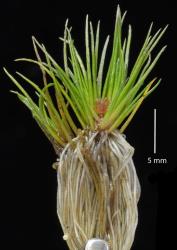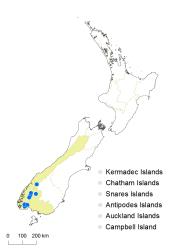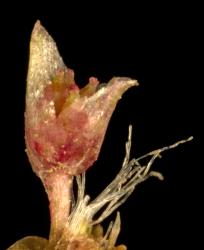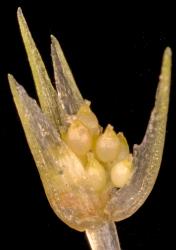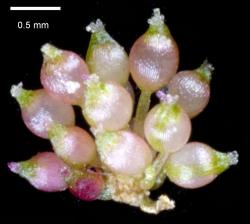- ≡ Trithuria brevistyla (K.A.Ford) de Lange & Mosyakin, Ukr. Bot. J. 76: 97 (2019)
Tufted, 10–40 mm in height. Apomictic, plants female only. Leaves 8–37 × 0.4–0.6 mm. Reproductive units 1–5 per tuft, on scapes 1–6 × 0.3–0.4 mm, terete, glabrous; involucral bracts 2–4(–7) ovate to broad-ovate or narrow-ovate. Female reproductive unit bracts 1.6–4.0 mm long, carpels 9–25, white to pinkish, with stigmatic hairs reduced to a knobbly capitate head <0.2 mm long. Fruits 0.39–0.56 × 0.3–0.5 mm, ovoid to globose.
Species delimitation in asexual or self-fertilising lineages is often problematic. We note that de Lange and Mosyakin (2019) have provided a combination at species rank for Trithuria inconspicua subsp. brevistyla. We reject their argument that species rank should be preferred over infraspecific ranks for threatened plants. They also stress a difference in breeding system between the two subspecies. However, both the subspecies of T. inconspicua and T. filamentosa exhibit apomixis, and Smissen et al. (2019) hypothesised a gradual transition from habitual self-fertilisation to apomixis. Smissen et al. (2019) also emphasised the subtle morphological differences between the two subspecies of T. inconspicua and described how similar T. inconspicua is to the Tasmanian T. filamentosa.
De Lange and Mosyakin cite Sokoloff et al. (2019), who utilised plastid DNA sequences (rbcL, atpB, matK and ndhF) in segregating species in the T. australis complex. Analysis of T. inconspicua subsp. brevistyla sequences for these loci (R.D. Smissen, unpublished: GenBank MN057954, MN057955, MN057956, MN057957) show that they are identical to those of T. inconspicua subsp. inconspicua (NC020372), and therefore plastid sequence diversity in T. inconspicua as circumscribed here is less than that in any of the groups proposed by Sokoloff et al. (2019) to be species in the T. australis complex.
Distinguished from T. inconspicua subsp. inconspicua by the carpels having stigmatic hairs reduced to a capitate head and the fruits ovoid to globose in shape compared with obvious septate hairs to 1 mm and fruits elliptic to ovoid in shape.
South Island: Southland – Lakes Pōteriteri, Hauroko, Manapōuri, Te Anau, and South Mavora Lake; Westland – Lake Sylvan.
Shallows of glacial lakes to a depth of about 0.3–2 m (rarely exposed above the water in a dry season), between 35–600 m a.s.l. Growing in sand, silt, and gravel, sometimes almost completely buried in muddy silt. Often part of the aquatic turf community, particularly with short-growing, shallow water-species (Wells et al. 1998).
Nationally Endangered A (3/1). Reported to be declining in Lake Manapōuri and absent from the previously recorded locality of Brod Bay in Lake Te Anau.
Flowering from at least late Jan–Feb; fruiting Mar–May.



